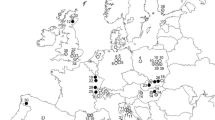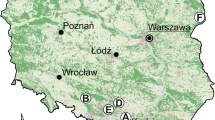Abstract
The domestic cat Felis catus has become a feral predator and conservation threat in many regions of the world. In the northern tropical savannas of Australia, there is limited data on feral cat diet, and there is evidence that some mammal populations in this region are starting to show signs of significant population decline. A total of 169 cat stomach samples were collected from north-eastern Australia from 1996 to 1998. Samples were collected from grassland and woodland habitats in winter and summer periods. A total of 106 unique prey types (grouped into 59 categories), representing 974 items, were recorded from all samples of which 8% were invertebrates, 9% amphibians, 41% reptiles, 20% birds, and 22% mammals. Relative significance of prey items was examined by calculating the Index of Relative Importance. Chi-square comparisons of frequency differences among habitat, season, and sex of cat were also undertaken. The most important prey items were grasshoppers (Orthoptera), centipedes (Chiloptera), dunnarts (Sminthopsis spp.), planigales (Planigale spp.), rabbits, quails (Turnix spp., Coturnix sp.), and geckos (Oedura spp., Gehyra spp.). Amphibians and invertebrates were more frequent in summer (wet season) samples, and mammals were more frequent in winter. Similarly, there were more amphibians in woodland samples and more invertebrates in grasslands. There was high dietary overlap and little difference in the diet of male versus female cats. Increasing cat predation in northern Australia may significantly affect the conservation of key groups already under decline (e.g., mammals) and careful innovative solutions to stem cat predation are needed.


Similar content being viewed by others
References
Abbott I (2002) Origin and spread of the cat, Felis catus, on mainland Australia, with a discussion of the magnitude of its early impact on native fauna. Wildl Res 29(1):51–74. doi:10.1071/wr01011
Australian Government (1999) The Environment Protection and Biodiversity Conservation Act. Australian Government, Canberra
Barratt DG (1997) Predation by house cats, Felis catus (L), in Canberra, Australia. 1. Prey composition and preference. Wildl Res 24(3):263–277. doi:10.1071/WR96020
Biro Z, Lanszki J, Szemethy L, Heltai M, Randi E (2005) Feeding habits of feral domestic cats (Felis catus), wild cats (Felis silvestris) and their hybrids: trophic niche overlap among cat groups in Hungary. J Zool Lond 266:187–196. doi:10.1017/s0952836905006771
Brickner-Braun I, Geffen E, Yom-Tov Y (2007) The domestic cat as a predator of Israeli wildlife. Isr J Ecol Evol 53(2):129–142. doi:10.1560/IJEE.53.2.129
Campos CB, Esteves CF, Ferraz K, Crawshaw PG, Verdade LM (2007) Diet of free-ranging cats and dogs in a suburban and rural environment, south-eastern Brazil. J Zool Lond 273(1):14–20. doi:10.1111/j.1469-7998.2007.00291.x
Catling PC (1988) Similarities and contrasts in the diets of foxes, Vulpes vulpes, and cats, Felis catus, relative to fluctuating prey populations and drought. Wildl Res 15:307–317. doi:10.1071/WR9880307
DEWHA (2008) Threat abatement plan for predation by feral cats. Department of the Environment, Water, Heritage and the Arts, Canberra
Dickman C (1996) Overview of the impacts of feral cats on Australian native fauna. Australian Nature Conservation Agency, Canberra
Dickman CR, Haythornthwaite AS, McNaught GH, Mahon PS, Tamayo B, Letnic M (2001) Population dynamics of three species of dasyurid marsupials in arid central Australia: a 10-year study. Wildl Res 28(5):493–506. doi:10.1071/WR00023
Fitzgerald BM (1988) Diet of domestic cats and their impact on prey populations. In: Turner DC, Bateson P (eds) The domestic cat: the biology of its behaviour. Cambridge University Press, Cambridge, pp 123–144
Garnett ST, Woinarski JCZ, Crowley GM, Kutt AS (2010) Biodiversity conservation in Australian tropical rangelands. In: Toit JD, Kock R, Deutsch J (eds) Wild rangelands: conserving wildlife while maintaining livestock in semi-arid ecosystems. Conservation science and practice no. 6. Blackwell Scientific, London, pp 191–234
Gillies C, Clout M (2003) The prey of domestic cats (Felis catus) in two suburbs of Auckland City, New Zealand. J Zool Lond 259:309–315. doi:10.1017/S095283690200328X
Hart RK, Calver MC, Dickman CR (2002) The index of relative importance: an alternative approach to reducing bias in descriptive studies of animal diets. Wildl Res 29(5):415–421. doi:10.1071/wr02009
Johnson CN (2006) Australia’s mammal extinctions. A 50 000 year history. Cambridge University Press, Port Melbourne
Johnson CN, VanDerWal J (2009) Evidence that dingoes limit abundance of a mesopredator in eastern Australian forests. J Appl Ecol 46(3):641–646. doi:10.1111/j.1365-2664.2009.01650.x
Johnson CN, Isaac JL, Fisher DO (2007) Rarity of a top predator triggers continent-wide collapse of mammal prey: dingoes and marsupials in Australia. Proc R Soc Biol Sci B 274(1608):341–346. doi:10.1098/rspb.2006.3711
Jones E, Coman BJ (1981) Ecology of the feral cat, Felis catus (L), in souther-eastern Australia.1. Diet. Aust Wildl Res 8(3):537–547. doi:10.1071/WR9810537
Kerle JA, Kutt AS, Read JL (2008) Desert mouse Pseudomys desertor. In: Dyck SV, Strahan R (eds) The mammals of Australia, 3rd edn. Reed New Holland, Sydney, pp 625–626
Kitchener A (1991) The natural history of wild cats. Christopher Helm, London
Letnic M, Dickman CR (2006) Boom means bust: interactions between the El Nino/Southern Oscillation (ENSO), rainfall and the processes threatening mammal species in arid Australia. Biodivers Conserv 15(12):3847–3880. doi:10.1007/s10531-005-0601-2
Martin GR, Twigg LE, Robinson DJ (1996) Comparison of the diet of feral cats from rural and pastoral Western Australia. Wildl Res 23(4):475–484. doi:10.1071/WR9960475
Medina FM, Garcia R (2007) Predation of insects by feral cats (Felis silvestris catus L., 1758) on an oceanic island (La Palma, Canary Island). J Insect Conserv 11(2):203–207. doi:10.1007/s10841-006-9036-7
Medina FM, Nogales M (2009) A review on the impacts of feral cats (Felis silvestris catus) in the Canary Islands: implications for the conservation of its endangered fauna. Biodivers Conserv 18(4):829–846. doi:10.1007/s10531-008-9503-4
Medina F, Oliveira P, Menezes D, Teixeira S, García R, Nogales M (2010) Trophic habits of feral cats in the high mountain shrublands of the Macaronesian islands (NW Africa, Atlantic Ocean). Acta Theriol 55(3):241–250. doi:10.4098/j.at.0001-7051.069.2009
Moro D (2003) Translocation of captive-bred dibblers Parantechinus apicalis (Marsupialia: Dasyuridae) to Escape Island, Western Australia. Biol Conserv 111:305–315. doi:10.1016/S0006-3207(02)00296-3
Moseby KE, Hill BM, Read JL (2009) Arid recovery—a comparison of reptile and small mammal populations inside and outside a large rabbit, cat and fox-proof exclosure in arid South Australia. Austral Ecol 34(2):156–169. doi:10.1111/j.1442-9993.2008.01916.x
Nogales M, Martin A, Tershy BR, Donlan CJ, Witch D, Puerta N, Wood B, Alonso J (2004) A review of feral cat eradication on islands. Conserv Biol 18(2):310–319. doi:10.1111/j.1523-1739.2004.00442.x
Paltridge R, Gibson D, Edwards G (1997) Diet of the feral cat (Felis catus) in central Australia. Wildl Res 24(1):67–76. doi:10.1071/WR96023
Pianka ER, Pianka HD (1976) Comparative ecology of twelve species of nocturnal lizards (Gekkonidae) in the Western Australian desert. Copeia 1976:125–142. doi:10.2307/1443783
Quillfeldt P, Schenk I, McGill RAR, Strange IJ, Masello JF, Gladbach A, Roesch V, Furness RW (2008) Introduced mammals coexist with seabirds at New Island, Falkland Islands: abundance, habitat preferences, and stable isotope analysis of diet. Polar Biol 31(3):333–349. doi:10.1007/s00300-007-0363-2
Read J, Bowen Z (2001) Population dynamics, diet and aspects of the biology of feral cats and foxes in arid South Australia. Wildl Res 28(2):195–203. doi:10.1071/WR99065
Rentz DC (1996) Grasshopper country: the abundant orthopteroid insects of Australia. University of New South Wales Press, Kensington
Richards GC (1989) Nocturnal activity of insectivorous bats relative to temperature and prey availability in tropical Queensland. Aust Wildl Res 16(2):151–158
Rolls E (1984) They all ran wild. Angus and Robertson, Sydney
Sattler P, Williams R (1999) The conservation status of Queensland’s bioregional ecosystems. Environmental Protection Agency, Brisbane
Slater P, Slater P, Slater R (2003) The slater field guide to Australian birds. New Holland, Sydney
Tracy CR, Reynolds SJ, McArthur L, Christian KA (2007) Ecology of aestivation in a cocoon-forming frog, Cyclorana australis (Hylidae). Copeia 2007(4):901–912. doi:10.1643/0045-8511(2007)7[901:EOAIAC]2.0.CO;2
Turner DC, Meister O (1988) Hunting behaviour of the domestic cat. In: Turner DC, Bateson P (eds) The domestic cat: the biology of its behaviour. Cambridge University Press, Cambridge, pp 111–122
Tyler MJ, Knight F (2009) Field guide to the frogs of Australia. CSIRO, Collingwood
Van Dyck S, Strahan R (2008) The mammals of Australia, 3rd edn. Reed New Holland, Sydney
Wilson S, Swan G (2003) A complete guide to reptiles of Australia. Reed New Holland, Sydney
Woinarski JCZ, Milne DJ, Wanganeen G (2001) Changes in mammal populations in relatively intact landscapes of Kakadu National Park, Northern Territory, Australia. Austral Ecol 26(4):360–370. doi:10.1046/j.1442-9993.2001.01121.x
Woinarski J, Mackey B, Nix H, Traill B (2007) The nature of Northern Australia: natural values, ecological processes and future prospects. ANU E, Canberra
Woods M, McDonald RA, Harris S (2003) Predation of wildlife by domestic cats Felis catus in Great Britain. Mamm Rev 33(2):174–188. doi:10.1046/j.1365-2907.2003.00017.x
Acknowledgements
This study was funded by an Australian Government National Estate grant and the Tropical Savannas Management CRC. Expert assistance with identification of stomach contents was provided by Steve Van Dyck, Heather Janetski, Andrew Amey, and Patrick Couper (Queensland Museum). The writing of this manuscript was supported by funding from the CSIRO Building Resilient Australian Biodiversity Assets Theme. Valuable comments on an early draft of this manuscript were provided by Professor Iain Gordon and Genevieve Perkins (CSIRO Ecosystem Sciences).
Author information
Authors and Affiliations
Corresponding author
Additional information
Communicated by: Krzysztof Schmidt
Appendix 1
Appendix 1
Rights and permissions
About this article
Cite this article
Kutt, A.S. The diet of the feral cat (Felis catus) in north-eastern Australia. Acta Theriol 56, 157–169 (2011). https://doi.org/10.1007/s13364-010-0016-7
Received:
Accepted:
Published:
Issue Date:
DOI: https://doi.org/10.1007/s13364-010-0016-7




